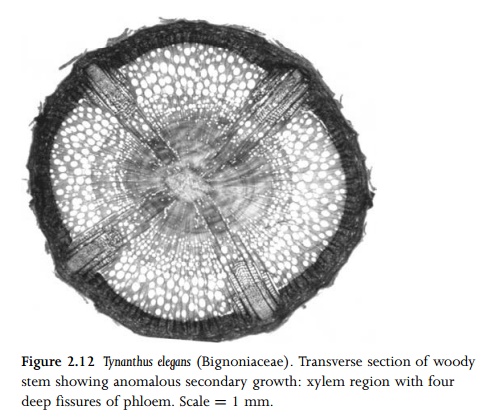Chapter: Anatomy of Flowering Plants: An Introduction to Structure and Development : Stem
Primary and Secondary Thickening Meristems
Primary and Secondary Thickening
Meristems
In monocots, which lack a vascular cambium, increase in stem diameter is typically relatively limited. However, most monocots and a few
other thick-stemmed angiosperms, especially species with short internodes and
crowded leaves, possess a primary thickening meristem (PTM) near the vegetative
shoot apex. The PTM (Fig. 2.13) is situated in the pericyclic
region. It consists of a narrow multiseriate zone of meristematic cells that
produces radial derivatives, usually a limited amount of parenchyma towards the
outside (centrifugally), and both parenchyma and discrete vascular bundles
towards the inside (centripetally). In addition to primary stem thickening, the
PTM is responsible for formation of linkages between root, stem and leaf
vasculature. Also, it frequently retains meristematic potential further down

The PTM
normally ceases activity at a short distance behind the apex, and subsequent
stem thickening is limited. Tree-forming palms possess an extensive PTM that
forms a large sunken apex; considerable further stem thickening occurs by
subsequent division and enlargement of ground parenchyma cells. This is termed
diffuse secondary growth.

In some woody monocots in the order Asparagales (e.g. Agave, Aloe, Cordyline, Yucca) further increase in stem thickness is achieved by means of a secondary thickening meristem (STM) (Fig. 2.14). The STM is essentially similar to the PTM in that it is located in the pericyclic region and produces radial derivatives. However, it is active further from the primary apex and produces second-ary vascular bundles that are often amphivasal and radially elongated. In some species (e.g. Nolina recurvata, Cordyline terminalis) the PTM and STM are axially discontinuous104,105, whereas in others (e.g. Yucca whipplei) they are axially continuous26. Apart from the distance from the apex, there are no precise criteria for distinguishing between derivatives of the two meristems, and transitional forms exist. Thus, they are perhaps best regarded as developmental phases of the same meristem.
The PTM
and STM are not homologous with the vascular cambium, because the vascular
derivatives are arranged in different ways. The vascular cambium produces
phloem centri-fugally and xylem centripetally, whereas most derivatives of the
PTM and STM are centripetal, and consist of a parenchyma-tous ground tissue and
discrete vascular bundles containing both xylem and phloem. Furthermore, the
PTM originates in ground tissue, is a tiered meristem, and is often fairly
diffuse, especially near the shoot apex (Fig. 2.13). By contrast the vascular
cambium is typically uniseriate and initially originates within vascular
tissue, though it later extends between bundles.

Related Topics